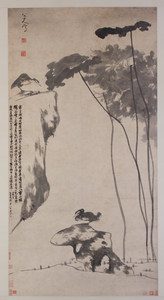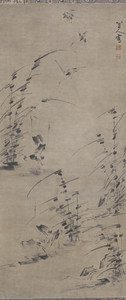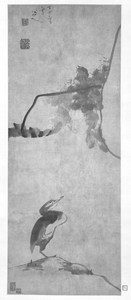Bada Shanren is considered one of the best Chinese-style artists ever. He also has a fascinating story.
Bada Shanren was born in 1626 as a Ming Dynasty Prince in Jiangxi Province, China. When the Ming Dynasty lost power, he hid for over 40 years at a Buddhist Monastery. When he left the monastery, he was in his 60s and decided to become a professional artist. Bada Shanren made intense sounds and loud noises while he painted; many people thought he was mad.
Table of Contents
- Who is the Chinese Painter Bada Shanren?
- Bada Shanren – The Poet
- Frequently Asked Questions
- Related Questions

Who is the Chinese Painter Bada Shanren?
Bada Shanren 八大山人 was born as Zhu Da in 1626 as a royal prince in Nanchang, Jiangxi Province, China. Bada Shanren is a pseudonym he took on for his art. Ba Da Shan Ren or as it is known in Chinese 八大山人, translates literally to mean the mountain man of the eight greats.
Art historians have named Bada Shanren one of the most brilliant and talented Chinese-style painters ever. His art style and artwork are still relevant today.
Bada Shanren – His Early Life
Bada Shanren did not have an easy life. Even though he was born into royalty as a Ming Prince, his father was disabled. His father helped nurture his son’s talent for drawing and calligraphy by ensuring Bada Shanren had the necessary training and tools for his art. His father understood that his son was a very talented artist.
In 1644, when he was about 18 years old, the Ming Emperor, who was in power, committed suicide. The Manchu army marched from the north, and a revolt was led by Li Zicheng, a former Ming official, to attack Beijing. The Ming Dynasty lost power, and the Qing dynasty came into power in China.
This was no doubt a traumatic event for the former Ming Prince. He no longer had his wealth and position in society secure. Hence, Bada Shanren needed to find a way to survive and to be able to evade what would more than likely be his death if the Qing Dynasty officials discovered him.

Bada Shanren – The Monk
Fearing for his life, Bada knew his days would be numbered under the new Qing Dynasty if he did not find a way to survive. He was a member of the Ming royal family, so a prize would have been put on his head. Bada sought refuge in a Buddhist Monastery, where he changed his name and became a Buddhist Monk.
We do not know a lot about his time as a Buddhist Monk. We can assume, as most Buddhist Monks, even today, he took a vow to poverty and spent his days chanting at the Temple. Because he was a Buddhist monk, we can also assume he was not married.
After living in the monastery for over 40 years, Bada finally thought it was safe for him to leave and develop his career as a professional painter. We do not know why he decided to leave the monastery, but one of the more obvious choices may be that he wanted to concentrate on his art.
He would have been about 60 years old when he left the monastery. Many years had passed with him living as a monk, so starting a new career at age 60 years old takes courage.
Bada Shanren – The Painter
When Bada Shanren started his career as a painter, he would use several pseudonyms. This most notable pseudonym is Ba Da Shan Ren 八大山人, which is what he is known as today.
Many scholars have speculated that Bada chooses the pseudonym of Bada Shanren due to the similarities between these Chinese characters 八大山人and the Chinese characters for the words “laugh” (笑) and “cry” (哭).
They felt that he was referring to the anguish and grief he felt about the fate that was now his life and his country. The truth is we may never know why he chose the name Bada Shanren, but for an artist who loved wordplay, he probably had a reason to choose the pseudonym is Ba Da Shan Ren.
Bada Shanren painted very provocative images of animals. They are lively and witty, but not anatomically correct as would have been more acceptable during his time. He would exaggerate the expression on the animal’s faces and even take liberties with the flora he painted.
Bada Shanren painted his works of art in the Chan Buddhist tradition. Chan Buddhist is similar to Japanese Zen Buddhism; many of his paintings have ended up in Japan, where he is very popular.

Bada Shanren – The Madman Artist
Bada Shanren screamed and made a lot of strange and loud noises while he painted. He was also said to be suffering from hearing loss. His paintings also feature sharp brush strokes, which are attributed to how he would hold his brushes sideways as he painted.
A few schools of thought about why Bada Shanren would scream like a madman while he painted. Some say it was because he wanted the authorities to think of him as mad so they did not look at him or his past. Others say it is because he was crazy. And some others say that he had a mental breakdown.
I think someone like Bada Shanren, who could produce such notable works of art, was not mad but was just clever enough to do what he needed to survive in the present political climate.
Bada Shanren – The Poet
Bada Shanren was not just a painter, but he was also a poet. But like any intellectual who was living in a police state that was hostile to him, he very carefully chose his words. His poems are thought to have many double meanings, so they are challenging to translate because of this.
We do know through his poems that he loved wordplay. Many of his poems have hidden double meanings. It could be he was giving out some hidden messages to his world that had become hostile to him because of his royal birth.
Bada Shanren is a fantastic Chinese artist. Not only does he have a fascinating life story, but he is also considered one of the top Chinese-style artists of all time.
Anita Louise Art is dedicated to art education, great artists, and inspiring others to find and create their art. We love art that uplifts and inspires. #ArtToMakeYouSmile! #ArtToMakeYouHappy!
If you want to see any of my art, you can find out more by clicking here. If you are interested in what inspires me and my paintings, you can discover more by clicking here.
We have a free newsletter and would love you to be part of our community; you can subscribe to the newsletter by clicking here. If you have any questions, I would be happy to talk to you anytime. You can reach me, Anita, by clicking here.
Subscribe to our Anita Louise Art YouTube Channel with great videos and information by clicking here.
Join us for our podcast “5 Minutes With Art.” just 5 minutes a week with us to discover and learn about great art and artists. You can find out more about our podcast by clicking here.
Frequently Asked Questions
Who was Bada Shanren?
Bada Shanren was a Chinese painter and calligrapher born in 1626. He was also a descendant of the Ming royal family and turned to a life of art and monasticism after the fall of the Ming dynasty
What is Bada Shanren famous for?
Bada Shanren is famous for his distinctive painting style, characterized by bold brushwork and a unique approach to composition. He is known for his landscapes, lotus flowers, and bird paintings, often imbued with a sense of emotion and expressionism.
What was Bada Shanren’s style of painting?
His style was marked by an individualistic and expressive approach, often blending traditional Chinese techniques with a more personal, idiosyncratic flair. His works often display a sense of solitude and introspection.
Did Bada Shanren have any other names?
Yes, he was born Zhu Da and had several other names throughout his life, including Bada Shanren, which he adopted later. He also used several pseudonyms, reflecting the common practice among Chinese literati of changing names to symbolize different stages in life or philosophical outlooks.
How did Bada Shanren’s background influence his art?
His royal background and the turmoil he experienced during the Ming-Qing transition deeply influenced his art. His works often reflect a sense of loss, melancholy, and a retreat into the spiritual and natural world. We
What are some of Bada Shanren’s most famous works?
Some of his most notable works include “Lotus and Birds,” “Fish and Rocks,” and various landscape paintings. His calligraphy and poetry are also highly regarded.
What sets Bada Shanren’s work apart from other artists of his time?
Bada Shanren’s work is distinguished by its emotional depth, minimalist approach, and his subjects’ often enigmatic or whimsical character. His ability to convey profound feelings with seemingly simple strokes sets him apart.
Did Bada Shanren follow any particular school of painting?
While earlier artists influenced him, Bada Shanren is often considered a highly individualistic artist who did not adhere strictly to one school. His style bridges the earlier Ming literati traditions and the emerging Qing dynasty styles.
What themes are prevalent in Bada Shanren’s paintings?
Themes of nature, spiritual longing, and introspection are prevalent in his work. He often depicted birds, flowers, and landscapes as metaphors for his inner experiences and philosophical beliefs.
How has Bada Shanren influenced modern art?
Bada Shanren’s influence extends to modern art, particularly in China, where his approach to expression and form has inspired contemporary artists. His works are studied for their unique blend of traditional technique and personal expression, offering insights into a transformative period in Chinese history and art.
Related Questions
What Is The Great Wave Off Kanagawa by Japanese Artist Hokusai (1790-1849)?
The Japanese artist Hokusai produced The Great Wave Off Kanagawa woodblock print as part of his series called Thirty-six Views. The Great Wave off Kanagawa features a huge wave, a small Mount Fuji in the background, and three boats getting caught in the large wave. This print has remained so popular that it inspired music, poetry, and even a present-day emoji.
You can find out more about the Great Wave off Kanagawa by reading our blog The Great Wave Off Kanagawa by Japanese Artist Hokusai (1790-1849) by clicking here.
Who is the Swedish Artist Hilma af Klint (1862-1944)?
Hilma af Klint was a Swedish woman artist who was painting revolutionary modern artwork for her time. A trailblazing, creative figure who kept her art and paintings secret for many years. Despite her notable works of art and legacy, she left us, it has only been during the last 40 years that she has started to gain international acclaim.
You can find out more about Hilma af Klint by reading our blog Who is the Swedish artist Hilma af Klint (1862-1944)? by clicking here.

